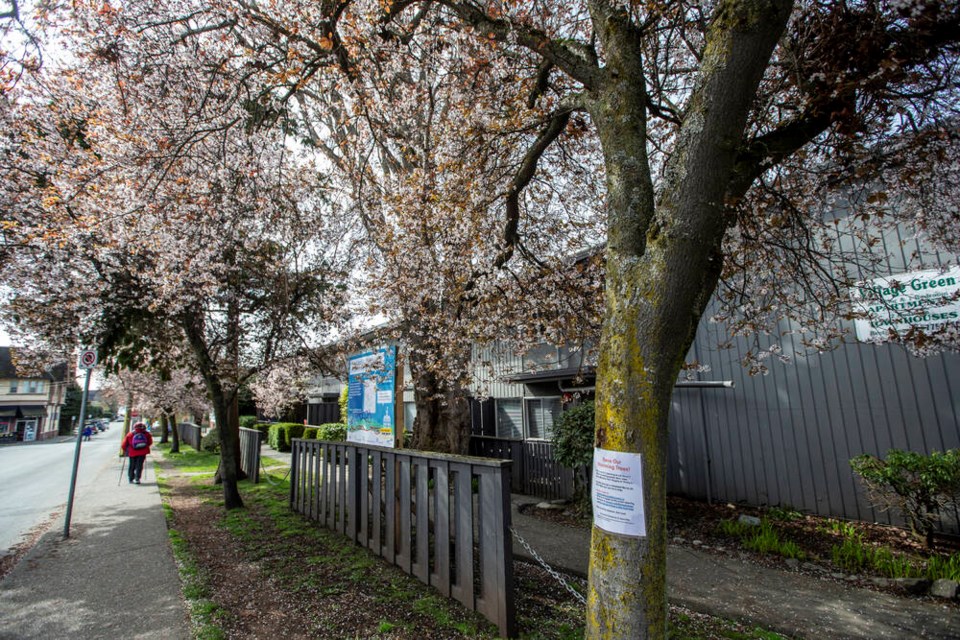At a public hearing on March 24, Victoria council members unanimously approved a new development in the heart of James Bay, despite overwhelming opposition to the proposal.
The developer proposed to demolish 45 units of affordable housing, to build a six-storey building with 137 market priced rental units. All existing tenants are to be displaced and a row of iconic flowering plum trees lining the city’s boulevard are to be destroyed. Additional trees on the property, 13 of them mature bylaw protected trees, are also to go.
The Times Colonist reported the opposition of “many in the neighbourhood” but also “a lot” of support for the project from “residents.” A review of all submissions shows 85 per cent of the submissions and presentations had concerns about the development. Only 15 per cent supported it, many coming from last-minute callers who identified as not from the community.
To say the community was not exactly keen is to state it mildly. To understand why, consider this: James Bay is already the highest density area of the city.
With property values soaring, and its proximity to downtown, development is fast and furious. Infill is rampant and older single family dwellings, even smaller multiple unit buildings, are fast disappearing to make way for bigger, higher and denser buildings. This trend threatens affordable housing for James Bay’s diverse population as older buildings are demolished and replaced by developments with greater profit margins.
To maximize land use, developers, with council approval, build more storeys, sacrifice green space, reduce setbacks to almost nothing, cut down more and more mature trees and cut back parking well below bylaw requirements.
James Bay is a community faced with the threat of becoming an extension of downtown and losing the character and charm that make it an attraction to visitors from all over Victoria and from around the world.
The magnitude of the grassroots opposition to this project is symptomatic of this ongoing threat. It gained momentum with the threat of cutting down decades-old flowering plum trees but the trees ignited long smouldering concerns that erupted to say: Look at what we have already given up and now you want more? Enough is enough.
The community’s reaction should have been a wake-up call for city council: Pleas to save the plum trees, concerns about excessive magnitude of the development and the most tragic consequence — the loss of 45 units of affordable housing and displacement of existing tenants from their homes and their community.
At the heart of these responses were key questions: How big is big enough? At what price density? Does more market rental housing justify eliminating affordable housing? Why are trees always dispensable? Why must we lose the character of our neighbourhood? Why is council not listening? Unfortunately, council was asleep at the wheel.
City staff admitted the plum trees were in fair condition and that it was the construction that would compromise their condition. Were it not for this development, they said, the trees would be retained and simply monitored to maintain their health.
This information presented an opening for a compromise and possible win-win. Reducing the magnitude of the building could potentially also save the trees! Alas, calls to consider alternatives fell on closed ears. The mayor and council all expressed “deep sadness” at the loss of the trees. They “wished” there was another way but none had the courage or imagination to demand one.
Council approved this development unanimously with no request for changes. But it does not resolve the ongoing concerns for James Bay, especially with phase two of the development already planned. City council says it had to find a balance. But what they need to balance is their zeal for “density intensification” at all cost, and developments that provide real benefits to the community.
They could start with demonstrating greater commitment to preserving mature trees by demanding consideration of alternatives and proof of necessity for any removals. They need to respect neighbourhood plans instead of overriding them. Council also must require developers who seek to demolish any low income or affordable housing to replace it with an equal number of units designated low income or affordable.
Anything less is empty rhetoric.
Council members need to take personal and collective responsibility for their decisions and no doubt will at the ballot box. It is also time to require that city councillors reside in Victoria to hold office.
Finally, it is time for Victoria to move to a ward system of representation where councillors are elected to represent and be accountable to their community.



